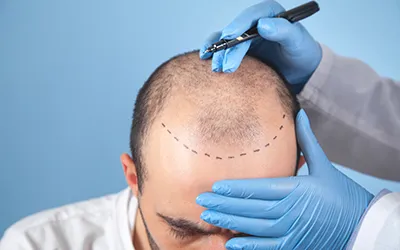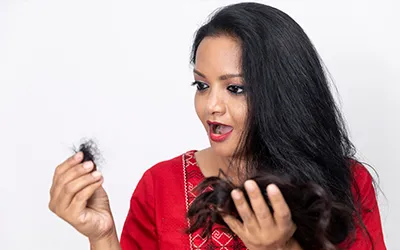

E-Brochure - Download Now!
Hair transplant surgery is a procedure utilised to address hair loss by transfering hair grafts from back and side of the scalp to bald or thinning areas. Various techniques are available for this purpose. At Diva Clinic, we understand the impact of hair loss on one's confidence and self-esteem. That's why we offer specialised hair transplant services aimed at providing natural-looking and long-lasting results. Our team of expert stylists and medical professionals are dedicated to helping clients achieve their desired hair restoration goals.
Hair transplant procedures primarily fall into two main categories: Follicular Unit Extraction (FUE) and Follicular Unit Transplantation (FUT), also known as strip harvesting. Here's an overview of each:
In FUE, individual follicular units containing one to four hairs are harvested directly from the donor area using a small punch tool.
FUT involves surgically removing a strip of scalp from the donor area, usually the back or sides of the head, where hair is abundant.
Both FUE and FUT can be further refined with specialised techniques such as Direct Hair Implantation (DHI) which involve the direct implantation of harvested grafts into the recipient area without the need for creating recipient sites beforehand.
Additionally, advancements in hair transplant technology have led to procedures like Body Hair Transplantation (BHT) , where hair follicles from other parts of the body, such as the beard, chest, axilla, pubic or legs, are transplanted to the scalp to enhance density or cover areas with limited donor hair on the scalp.
In FUE, individual follicular units containing one to four hairs are harvested directly from the donor area using a small punch tool.
Choosing a reputable medical practitioner is vital. During the consultation, discuss various medical issues, including:
Following surgery, expect:
Potential complications include risks related to anaesthesia, such as allergic reactions. There may be risks of bleeding, infection, scarring, and nerve damage. In some cases, further surgery may be required. It's important to address any concerns with your medical practitioner before undergoing the procedure.
Following surgery, it's crucial to adhere to all wound care instructions provided by your medical practitioner. Avoid engaging in strenuous activities that may increase blood pressure and risk of bleeding. If you experience any unusual symptoms, promptly report them to your medical practitioner for proper evaluation and management.
Following hair transplant surgery, most patients experience successful hair regrowth within a few months. While initial shedding may occur, new, permanent hair gradually emerges. Scarring from the procedure typically fades over time, blending with surrounding hair. Touch-up surgeries may be recommended for optimal results, addressing any areas of concern. Overall, patients can expect natural-looking, lasting improvements in hair density and appearance, enhancing their confidence.
The cost of hair transplant in India can vary depending on various factors such as the clinic's location, the surgeon's experience, the technique used, and the number of grafts required. On average, hair transplant costs in India can range from ₹40,000 to ₹1,50,000 or more.
It's essential to consult with a reputable clinic and surgeon to get an accurate estimate based on your specific needs and expectations.
At Diva Clinic, we offer cutting-edge hair transplant procedures that set us apart:

Transplant a large number of Follicular Unit grafts (FUE) in a single day, ideal for significant hair restoration.

Utilise Body Hair Transplant (B.H.T.) techniques for denser hair restoration.

Combine FUT with FUE for maximum graft extraction in a single day.
With Diva Clinic, experience unparalleled expertise, personalised care, and comprehensive solutions tailored to your unique needs. Discover the artistry of transformation under Dr. Vivek Kumar Saxena's expert hands and unlock your beauty potential with us.
Diva Clinic offers Follicular Unit Extraction (FUE), Follicular Unit Transplantation (FUT), Direct Hair Implantation (DHI), and Body Hair Transplantation (BHT) for tailored hair restoration solutions.
FUE is minimally invasive, leaves no linear scar, and allows faster recovery, making it ideal for patients who prefer short hairstyles, unlike FUT which involves a strip removal and can leave a visible scar.
You may experience swelling, numbness, and scabbing on treated areas, with dressings applied for a few days. It’s important to follow post-operative care instructions to ensure proper healing.
Hair transplant costs vary based on technique, number of grafts, and patient needs. At Diva Clinic, prices typically range from ₹40,000 to ₹1,50,000 depending on the procedure complexity.
Diva Clinic is located at 1st floor, 2/156 Vivek Khand-2, Near PNB Bank, Railway Station Road, Gomti Nagar, Lucknow – 226010.